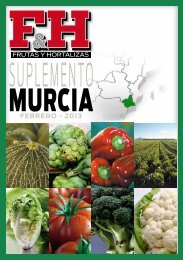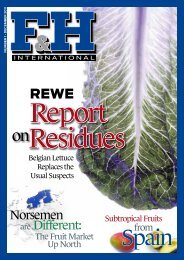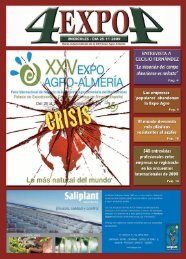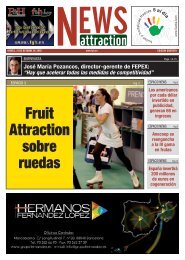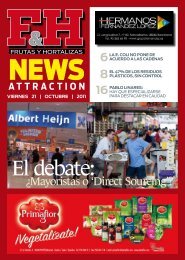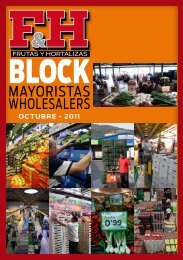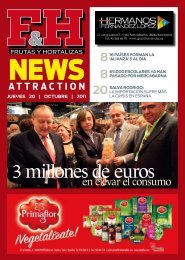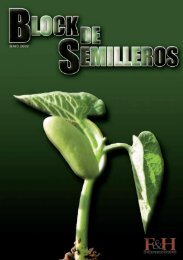Markets - Revista F&H
Markets - Revista F&H
Markets - Revista F&H
Create successful ePaper yourself
Turn your PDF publications into a flip-book with our unique Google optimized e-Paper software.
16<br />
Melon southeastern Spain |<br />
Interest grows in ‘Piel de sapo’<br />
THE ‘PIEL DE SAPO’ MELON INCREASES ITS FIGURES. HOWEVER, THE SEEDS TRY TO<br />
LOOK FOR MATERIALS WITH FLAVOR AND GOOD CONSERVATION.<br />
The farmer demands varieties<br />
that cover the production<br />
cycle; the consumer<br />
is attracted by the varieties<br />
with a high sugar level and<br />
the supermarkets are looking<br />
for long life products on<br />
their shelves.<br />
The commitment of the<br />
seed companies focus on<br />
offering long life products<br />
in the supermarkets without<br />
losing the main features<br />
of the melon: smell<br />
and taste, among others<br />
aspects.<br />
There are markets that ask<br />
F&H International • April 2013 <strong>Markets</strong><br />
Galia melons as in certain<br />
supermarkets of United<br />
Kingdom, although most of<br />
the seed companies say that<br />
this type of melon has its<br />
sell-by date in a short time.<br />
In the south-eastern of<br />
Spain there is an interest<br />
in ‘piel de sapo’ melon. In<br />
fact, the surface of melon in<br />
greenhouse in Murcia has<br />
had an upward trend in the<br />
last three years. The figures<br />
of 2011 show 250 hectares,<br />
respect to 220 hectares of<br />
2010 or 190 hectares in<br />
2009. The volume has also<br />
had an increase.<br />
With regard to the melon<br />
harvested in the open, the<br />
farmers have a positive<br />
trend because there is more<br />
surface, in particular more<br />
than 2,400 hectares.<br />
Piel de sapo melon has the<br />
first position in production<br />
in Almeria. In fact, number<br />
of hectares have had an<br />
evolution in four years, until<br />
1,470 hectares.<br />
“Last year was planted in<br />
Almeria more Piel de sapo<br />
melon, even ended later<br />
with a good quality of mel-<br />
on, while other types, such<br />
as Galia and Cantaloupe,<br />
decreased the volume.<br />
However, the melon depends<br />
on the results of previous<br />
crops, such as tomato,<br />
pepper and cucumber<br />
to know what is going to<br />
happen the coming year”,<br />
explains Joaquín Navarro<br />
of Sakata.<br />
The demand for melon continues<br />
to increase because<br />
seed companies, farmers,<br />
supermarkets and traditional<br />
shops are looking for<br />
a high quality product.




